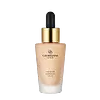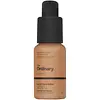What's inside
What's inside
 Key Ingredients
Key Ingredients

 Benefits
Benefits

No benefits
 Concerns
Concerns

 Ingredients Side-by-side
Ingredients Side-by-side

Cyclopentasiloxane
EmollientWater
Skin ConditioningCaprylyl Methicone
Skin ConditioningCoconut Alkanes
EmollientTrimethylsiloxysilicate
EmollientPEG-9 Polydimethylsiloxyethyl Dimethicone
EmulsifyingCoco-Caprylate/Caprate
EmollientDimethicone/PEG-10/15 Crosspolymer
Cetyl Diglyceryl Tris(Trimethylsiloxy)Silylethyl Dimethicone
Emulsion StabilisingDipropylene Glycol
HumectantTocopherol
AntioxidantPolyglyceryl-3 Diisostearate
EmulsifyingPolyglyceryl-3 Polyricinoleate
EmulsifyingPolyglyceryl-4 Isostearate
EmulsifyingDisteardimonium Hectorite
StabilisingHectorite
AbsorbentSodium Chloride
MaskingHexyl Laurate
EmollientDimethicone/Vinyl Dimethicone Crosspolymer
Skin ConditioningPEG-10 Dimethicone
Skin ConditioningStearic Acid
CleansingMethyl Methacrylate Crosspolymer
Alumina
AbrasiveTrisodium Ethylenediamine Disuccinate
Phenoxyethanol
PreservativeChlorphenesin
AntimicrobialCI 77891
Cosmetic ColorantIron Oxides
Tin Oxide
AbrasiveAluminum Hydroxide
EmollientCI 77163
Cosmetic ColorantMica
Cosmetic ColorantMagnesium Stearate
Cosmetic ColorantTriethoxycaprylylsilane
Cyclopentasiloxane, Water, Caprylyl Methicone, Coconut Alkanes, Trimethylsiloxysilicate, PEG-9 Polydimethylsiloxyethyl Dimethicone, Coco-Caprylate/Caprate, Dimethicone/PEG-10/15 Crosspolymer, Cetyl Diglyceryl Tris(Trimethylsiloxy)Silylethyl Dimethicone, Dipropylene Glycol, Tocopherol, Polyglyceryl-3 Diisostearate, Polyglyceryl-3 Polyricinoleate, Polyglyceryl-4 Isostearate, Disteardimonium Hectorite, Hectorite, Sodium Chloride, Hexyl Laurate, Dimethicone/Vinyl Dimethicone Crosspolymer, PEG-10 Dimethicone, Stearic Acid, Methyl Methacrylate Crosspolymer, Alumina, Trisodium Ethylenediamine Disuccinate, Phenoxyethanol, Chlorphenesin, CI 77891, Iron Oxides, Tin Oxide, Aluminum Hydroxide, CI 77163, Mica, Magnesium Stearate, Triethoxycaprylylsilane
Ingredients Explained
These ingredients are found in both products.
Ingredients higher up in an ingredient list are typically present in a larger amount.
Alumina is another name for the compound aluminum oxide. It is used as a thickener, absorbent, and abrasive.
As an absorbent, alumina can give a mattifying effect. It is used in mineral sunscreens to help coat nano-sized filters, such as titanium dioxide. By increasing the size of the UV filters, these ingredients stay on the skin for a longer time. By coating small sized ingredients, alumina helps thicken a product.
Alumina may be used as an abrasive, or exfoliant.
Alumina is naturally occurring in the mineral corundum. Certain varieties of corundum create rubies and sapphires. Corundum is also the crystalline form of alumina.
Learn more about AluminaCi 77891 is a white pigment from Titanium dioxide. It is naturally found in minerals such as rutile and ilmenite.
It's main function is to add a white color to cosmetics. It can also be mixed with other colors to create different shades.
Ci 77891 is commonly found in sunscreens due to its ability to block UV rays.
Learn more about CI 77891This ingredient is a silicone used to improve the texture of products and absorb oil. It does not get absorbed into the skin.
Like other silicones, Dimethicone/Vinyl Dimethicone Crosspolymer helps condition the skin by creating a barrier. In this sense, it can act as an emollient and trap moisture in.
This ingredient is a type of elastomer.
Learn more about Dimethicone/Vinyl Dimethicone CrosspolymerDisteardimonium Hectorite comes from the clay mineral named hectorite. It is used to add thickness to a product.
It can also help stabilize a product by helping to disperse other ingredients.
Hectorite is a rare, white clay mineral.
Learn more about Disteardimonium HectoriteThis ingredient comes as a powder made up of small, porous, microbeads. It is used to add a silky feel to products and also helps absorb oil.
Peg-10 Dimethicone is silicone with conditioner and emulsifier properties. It mostly acts as an emollient in skincare and and humectant in haircare.
According to the manufacturer, acidic formulations decrease the stability of this ingredient. It works best in neutral or near neutral formulations.
Triethoxycaprylylsilane is a silicone used to bind and stabilize ingredients.
As an emulsifier, it helps prevent ingredients from separating. This can help elongate the shelf life of products.
Triethoxycaprylylsilane is often used to coat mineral sunscreens ingredients to help give a better feel. It also helps reduce oxidative stress in sunscreens.
Learn more about TriethoxycaprylylsilaneWater. It's the most common cosmetic ingredient of all. You'll usually see it at the top of ingredient lists, meaning that it makes up the largest part of the product.
So why is it so popular? Water most often acts as a solvent - this means that it helps dissolve other ingredients into the formulation.
You'll also recognize water as that liquid we all need to stay alive. If you see this, drink a glass of water. Stay hydrated!
Learn more about Water